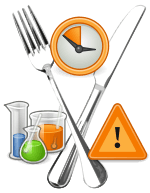Critical control point
 | |
| Terms | |
|---|---|
| Foodborne illness | |
| Hazard analysis and critical control points (HACCP) • Hazard analysis and risk-based preventive controls (HARPC) | |
| Critical control point | |
| Critical factors | |
| FAT TOM | |
| pH | |
| Water activity (aw) | |
| Bacterial pathogens | |
| Clostridium botulinum | |
| Escherichia coli | |
| Listeria | |
| Salmonella | |
| Vibrio cholerae | |
| Viral pathogens | |
| Enterovirus | |
| Hepatitis A | |
| Norovirus | |
| Rotavirus | |
| Parasitic pathogens | |
| Cryptosporidium | |
| Entamoeba histolytica | |
| Giardia | |
| Trichinella | |
Critical control point (CCP) is the point where failure of standard operation procedure (SOP) could cause harm to customers and to the business, or even loss of the business itself. It is a point, step or procedure at which controls can be applied and a food safety hazard can be prevented, eliminated or reduced to acceptable (critical) levels. The most common CCP is cooking, where food safety managers designate critical limits.
Food in cooking
In the United States, the Food and Drug Administration (FDA) establishes minimum internal temperatures for cooked foods. It is important to remember that these values can be superseded by state or local health code requirements, but they cannot be below the FDA limits. Temperatures should be measured with a probe thermometer in the thickest part of meats, or the center of other dishes, avoiding bones and container sides. Minimum internal temperatures are set as follows:
165°F (74°C) for 156 seconds
- Poultry (such as whole or ground chicken, turkey, or duck)
- Stuffed meats, fish, poultry, and pasta
- Any previously cooked foods that are reheated from a temperature below 135°F (57°C), provided they have been refrigerated or warm less than 2 hours
- Any potentially hazardous foods cooked in a microwave, such as poultry, meat, fish, or eggs
155°F (68°C) for 15 seconds
- Ground meats (such as beef or pork)
- Injected meats (such as flavor-injected roasts or brined hams)
- Ground or minced fish
- Eggs that will be held for a length of time before eaten
145°F (63°C) for 15 seconds
- Steaks and chops such as beef, pork, veal, and lamb
- Fish
- Eggs cooked for immediate service
145°F (63°C) for 4 minutes
- Roasts (can be cooked to lower temperatures for increased lengths of time)
135°F (57°C) for 15 seconds
- Cooked fruits or vegetables that will be held for a length of time before eaten
- Any commercially processed, ready-to-eat foods that will be held for a length of time before eaten
In addition, hot food must be held at a minimum internal of 135°F (57°C) if it is not immediately consumed. The temperature must be checked every 4 hours or else labeled with a discard time. Although monitored hot food can be held indefinitely in this way without a food safety concern, the nutritional value, flavor, and quality can suffer over long periods.
Fresh-cut fruits and vegetables
Fruits and vegetables are liable to have microbiological contamination, such as with the bacteria of Escherichia coli O157:H7, Salmonella enteritidis and Listeria monocytogenes, perhaps due to a post harvest mishandling. There are several methods and protocols which are able to reduce or even eliminate the pathogens and these include
- Proper harvest and post-harvest handling [1], [2], [3]
- Inactivation of microbials by irradiation [4]
- Sanitization of fruits and vegetables using food grade chemicals [5], [6]
See also
References
- ↑ International Fresh-cut Produce Association; Produce Marketing Association; United Fresh Fruit and Vegetable Association; Western Growers. "Commodity specific food safety guidelines for the lettuce and leafy greens supply chain <internet>" (PDF). Archived from the original (PDF) on 29 September 2007. Retrieved 2 August 2007.
- ↑ Produce Marketing Association; United Fresh Fruit and Vegetable Association. "Commodity specific food safety guidelines for the melon supply chain <internet>" (PDF). Archived from the original (PDF) on 29 September 2007. Retrieved 2 August 2007.
- ↑ North American Trade Work Group. "Commodity specific food safety guidelines for the Fresh Tomato supply chain <internet>" (PDF). Archived from the original (PDF) on 26 September 2007. Retrieved 4 August 2007.
- ↑ IAEA-TECDOC-1530. "Use of irradiation to ensure the hygienic quality of fresh, pre-cut fruits and vegetables and other minimally processed food of plant origin <internet>" (PDF). Retrieved 2 August 2007.
- ↑ Parish, M.E.; et al. "Methods to reduce/eliminate pathogens from fresh and fresh-cut produce <internet>" (PDF). Retrieved 2 August 2007.
- ↑ Deza, M.A.; et al. "Inactivation of Escherichia coli O157:H7, Salmonella enteritidis and Listeria monocytogenes on the surface of tomatoes by neutral electrolyzed water <internet>" (PDF). Archived from the original (PDF) on 28 September 2007. Retrieved 2 August 2007.
